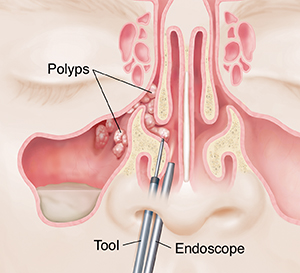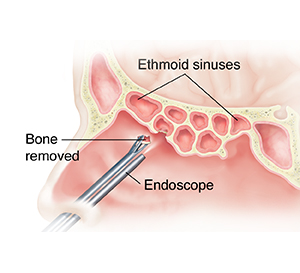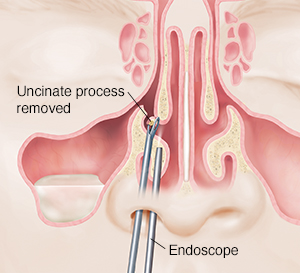Endoscopic Sinus Surgery
Endoscopic Sinus Surgery
The sinuses are hollow areas formed by the bones of the face. Normally, a thin layer of mucus drains from the sinuses into the nose. If the drainage path is blocked, problems such as infection can result. Endoscopic sinus surgery can be done to help clear blockages. The surgeon uses a thin, lighted tube (endoscope) that is put into your nose. The tube lets the doctor see and operate inside your nose and sinuses.
Straightening the septum
The septum is a piece of cartilage and bone that runs straight down the inside of the nose. It divides the nose into two sides. A deviated septum is crooked instead of straight. A crooked septum can cause breathing problems. To fix a deviated septum, the doctor reshapes or trims the cartilage and bone. There is enough septum left for the nose to hold its shape. But the air has more space to move in and out of the nose. This improves your breathing.
Removing polyps
Polyps are small growths. They can grow in both the nose and sinuses. The surgeon may use different methods to remove them. Often, the surgeon uses special tools to remove polyps without harming nearby tissues.
Opening the ethmoid sinuses
The ethmoid sinuses are made up of many small air spaces, like a honeycomb. Like the other sinuses, the ethmoids have a lining that makes mucus. In some cases the drainage path is blocked. The doctor may open the thin walls of bone that separate the air spaces. This creates a passage for mucus to drain more easily.
Clearing the major outflow pathway of the sinuses
The osteomeatal complex is a term for a major outflow tract of your sinuses. Similar to a traffic jam, when this area becomes blocked, you may get symptoms in your maxillary, ethmoid, and frontal sinuses. Opening this area is a primary step in most sinus surgeries. The uncinate process is a small piece of bone and tissue in the sinuses. It forms an outlet for part of the sinuses. If this tissue is swollen (inflamed), it will block drainage of mucus. The doctor may remove the uncinate process so that mucus can drain.
Updated:
March 21, 2017
Sources:
Acute sinusitis and rhinosinusitis in adults: Clinical manifestations and diagnosis. UpToDate.
Reviewed By:
Fraser, Marianne, MSN, RN,Image reviewed by StayWell medical illustration team.,Kacker, Ashutosh, MD



